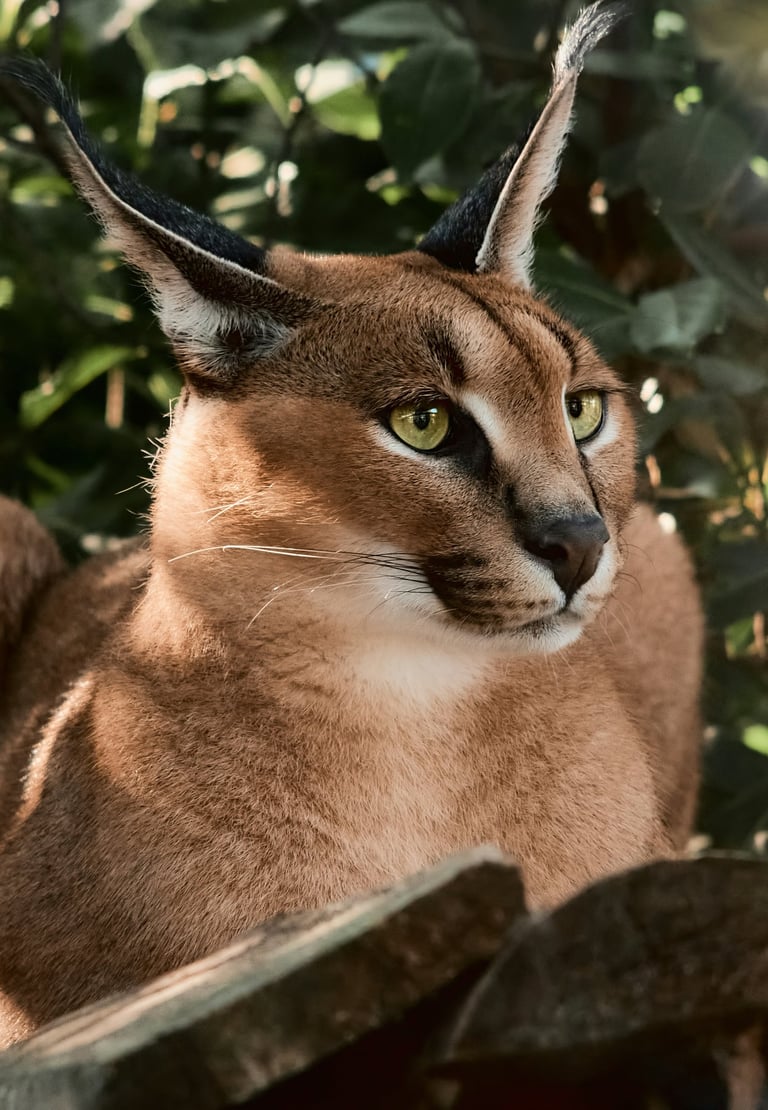The Mysterious Beauty of the Caracal: The Desert Lynx
JOURNAL


Physical Characteristics: A Closer Look at the Caracal
The caracal's distinctive physical attributes are what set this remarkable feline apart from other members of the cat family. With its sleek and streamlined body, the caracal exudes a sense of grace and agility. Its short, reddish-gold coat, which conspicuously lacks spots or stripes, is both aesthetically striking and functionally adept at blending into the arid landscapes it inhabits.
Dramatic facial markings enhance the caracal's expressive appearance. Black, swept-back ear tufts, which can measure up to five centimeters in length, are among its most recognizable features. These tufts are not just for show; they play a crucial role in communication and camouflage. The facial structure itself is marked by prominent, almost regal eyes that seem to pierce through the desert mirage, offering a glimpse into the caracal's acute perception abilities.
The caracal's body is proportionally slimmer and more elongated compared to the true lynx, contributing to its exceptional speed and agility. This feline possesses significantly longer legs, which allow it to make impressive vertical leaps of up to three meters and horizontal bounds over considerable distances. These powerful limbs, coupled with muscular development, render the caracal one of the swiftest and most formidable predators in its size category.
Among small cats in Africa, the caracal stands out not only as the fastest but also the heaviest, often weighing between 8 to 19 kilograms. This robust build does not detract from its nimbleness; rather, it fortifies its capability to hunt and dominate in its natural habitat. These physical characteristics make the caracal a master of the semi-arid regions it calls home, embodying a blend of beauty and ferocity that captures the imagination.
Habitat and Behavior: Life of a Desert Lynx
The caracal, often referred to as the "desert lynx," thrives in an array of diverse habitats, including savannas, woodlands, and semi-deserts. Unlike many of its feline counterparts such as the serval and the African golden cat, the caracal exhibits a unique adaptability to arid and semi-arid environments. This adaptability underscores its versatility and the intricate balance between its physical attributes and the environment it inhabits.
These distinct environments foster the caracal’s primary behaviors. Caracals are solitary creatures, typically active at night, embodying a meticulous predator within their ecosystem. Their hunting expertise is marked by precision and power. With keen eyesight and an impressive leap that allows them to catch flying birds mid-air, caracals frequently hunt small to medium-sized mammals, birds, and even reptiles. The elongated legs and streamlined body of the caracal are significant physical adaptations that support its agile hunting style, enabling rapid sprints and high jumps that are crucial in its territory.
Caracals usually mark their territory with scent markings and exhibit a strong sense of independence, rarely interacting with other caracals except in mating season or while raising cubs. Their solitary nature is a stark contrast to the social dynamics seen in other species, such as the serval, which although similar in habitat, relies more heavily on wetlands and is usually more active during the day. Similarly, African golden cats are more reclusive and often inhabit dense forests, preferring a more concealed lifestyle compared to the caracal’s adaptability to open terrains.
Such ecological variances highlight the caracal's unique niche in the animal kingdom, reinforcing the delicate synergy between its evolutionary traits and the demanding environments of savannas and semi-arid regions. This adaptability not only ensures its survival but also underscores its role as a versatile and tenacious predator in some of the world’s most challenging habitats.
Family Tree: The Caracal's Place Among the Felines
The caracal, often dubbed the "Desert Lynx," occupies a fascinating yet sometimes confusing position within the feline family tree. This medium-sized wild cat, renowned for its striking ear tufts and sleek build, has intrigued zoologists and researchers seeking to elucidate its lineage and relationships with other wild cats. Caracals belong to the genus Caracal, which includes only a single species, thus highlighting its distinctiveness.
Despite its unique genus, the caracal shares several similarities with other felines, specifically the serval and the African golden cat, both of which belong to the genus Leptailurus. Historically, the caracal, serval, and golden cat were once grouped together under the same genus due to their overlapping characteristics. However, more recent genetic and morphological studies have afforded the caracal its own genus, Caracal, emphasizing its distinct evolutionary path.
Both the caracal and serval exhibit comparable sizes, typically weighing between 8 and 19 kilograms, and possessing agile bodies designed for hunting. However, differences in their habitats and physical markings distinguish them. The serval, characterized by its long legs and spotted coat, primarily inhabits sub-Saharan Africa's wetlands and savannas. In contrast, the caracal is highly adaptable and can be found across various arid regions of Africa, the Middle East, and Central Asia, showcasing a more uniform, tawny coat adapted for desert camouflage.
The African golden cat, while also closely related, is slightly smaller and thrives in Africa's dense, tropical forests, illustrating a stark habitat divergence from the caracal. Unlike the caracal's adeptness at leaping to catch airborne prey, the golden cat predominantly relies on stealth and ambush tactics, showcasing behavioral divergences aligned with their respective environments.
Unique features that set the caracal apart from its relatives include its remarkable ear tufts, long legs, and powerful hindquarters, all of which contribute to its exceptional leaping ability. These attributes are not just for aesthetic appeal but serve functional purposes, such as communication and thermoregulation. Such evolutionary distinctions underline the caracal's unique adaptation to survival in some of the world's most challenging environments.
Understanding the caracal's place within the broader family of cats offers us a more comprehensive appreciation of its evolutionary history and adaptability, marking it as an exceptional species among the small wild cats.
